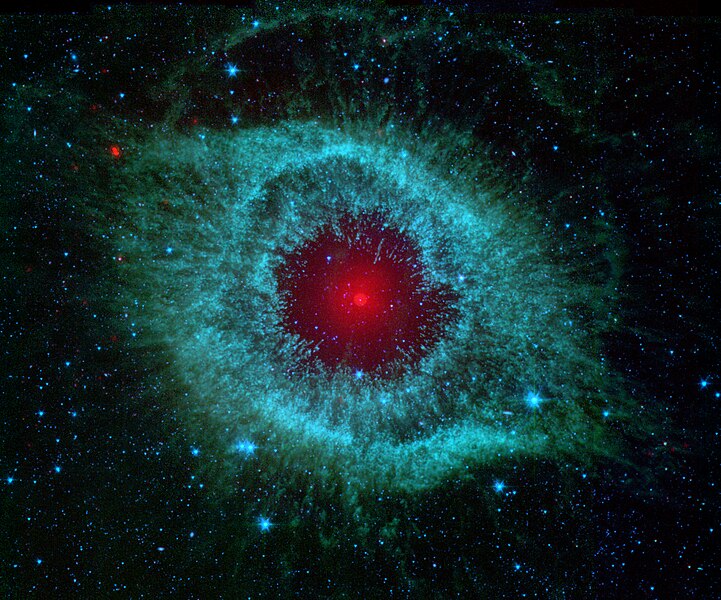Датотека:Comets Kick up Dust in Helix Nebula (PIA09178).jpg
Appearance

Veličina ovog prikaza: 721 × 600 piksela. 6 drugih rezolucija: 289 × 240 piksela | 577 × 480 piksela | 923 × 768 piksela | 1.231 × 1.024 piksela | 2.462 × 2.048 piksela | 4.279 × 3.559 piksela.
Originalna datoteka (4.279 × 3.559 piksela, veličina datoteke: 7,22 MB, MIME tip: image/jpeg)
Istorija datoteke
Kliknite na datum/vreme da biste videli tadašnju verziju datoteke.
| Datum/vreme | Minijatura | Dimenzije | Korisnik | Komentar | |
|---|---|---|---|---|---|
| trenutna | 04:43, 13. februar 2007. |  | 4.279 × 3.559 (7,22 MB) | Startaq | {{Information |Description=This infrared image from NASA's Spitzer Space Telescope shows the Helix nebula, a cosmic starlet often photographed by amateur astronomers for its vivid colors and eerie resemblance to a giant eye. The nebula, located about 700 |
Upotreba datoteke
2 sledeće stranice koriste ovu datoteku:
Globalna upotreba datoteke
Drugi vikiji koji koriste ovu datoteku:
- Upotreba na af.wikipedia.org
- Upotreba na ar.wikipedia.org
- Upotreba na arz.wikipedia.org
- Upotreba na ast.wikipedia.org
- Upotreba na ba.wikipedia.org
- Upotreba na bg.wikipedia.org
- Upotreba na bjn.wikipedia.org
- Upotreba na bn.wikipedia.org
- Upotreba na br.wikipedia.org
- Upotreba na ca.wikipedia.org
- Upotreba na cs.wikipedia.org
- Upotreba na de.wikipedia.org
- Upotreba na dsb.wikipedia.org
- Upotreba na en.wikipedia.org
- Helix Nebula
- Spitzer Space Telescope
- Comet nucleus
- Portal:Outer space
- Talk:Helix Nebula
- User:Swirlex/Userboxes
- User:Swirlex/Userboxcode
- NASA
- Wikipedia:Featured pictures/Space/Looking out
- User:Nonexyst
- User:Benjamin112
- Portal:Outer space/Selected picture
- User:Sunfishtommy/sandbox
- Wikipedia:Featured pictures thumbs/44
- Wikipedia:Featured picture candidates/October-2014
- User talk:Benison/Archive 19
- Wikipedia:Featured picture candidates/The God's Eye
- Wikipedia:Picture of the day/October 2016
- Template:POTD/2016-10-12
- Wikipedia:Main Page history/2016 October 12
- User talk:69.50.70.9
- User:The NMI User
- User:Corinne/subpage
- User talk:Benison/Archive 37
- Wikipedia:Userboxes/Science/Astronomy
- User:Catfurball
Još globalnog korišćenja ove datoteke.




